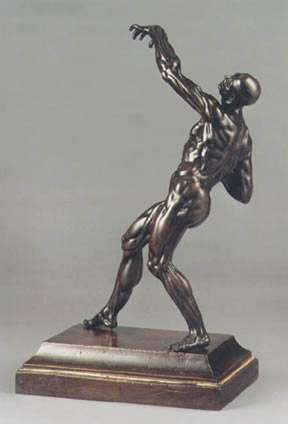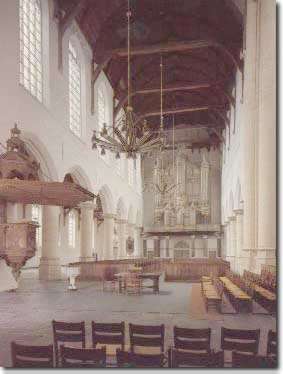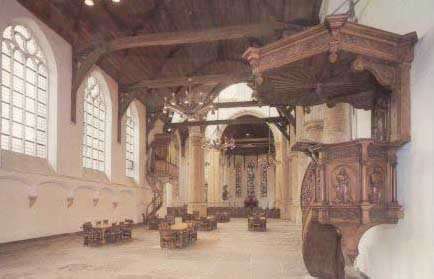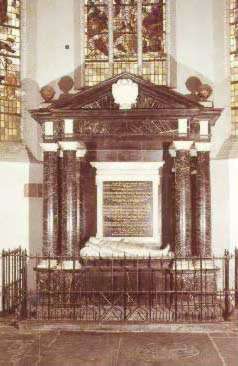Willem Danielszoon van Tetrode was een bekend kunstenaar. Hij trok in 1549 naar Italië en maakte daarna fuore in Holland. In de oude kerk van zijn vermoedelijke geboortestad Delft stond een groot beeld, dat de Apostelen en de Verlosser voorstelde. Na de beeldenstorm van 1566 was er niet meer dan `een romp` van over. Guglielmo Fiammingo, zoals hij zich noemde in Florence, kreeg opdracht een nieuw kunstwerk te maken voor de kerk. In 1568 werd een contract getekend en voor 1571 was het werk vrijwel klaar.
Willem Danielsz. van TETRODEknown as Guglielmo Fiammingo
Height: 17 in. : 43 cm. (to raised hand, excluding base)
Anatomical figure of a falling ManBronze statuette
Delft, circa 1525 - died 1580
 |
Tetrode (1) was probably born in Delft, as his parents lived there. By the summer of 1548 he was already in Florence and is recorded working as an assistant to Benvenuto Cellini on Perseus (2); the base of which was designed by Tetrode, for which he received payment in September 1551. He also undertook most of the restoration work on an antique torso which Cellini transformed into Ganymede (Bargello) (3). Shortly after completing the base of Perseus he left Florence for Rome where he entered the workshop of Guglielmo della Porta and became involved with the restoration of recently excavated Roman statuary. |
Tetrode was in Rome again in October 1562, but the suggestion that he returned to Florence to assist Bartolommeo Ammanati with the Neptune fountain for the Piazza della Signoria has yet to be proven. Returning to Delft, possibly via Munich (7), Tetrode signed a contract for the high altar of the Oude Kerk on 9 March 1568. This was an elaborate structure in alabaster, marble, stone, wood and copper on which he worked for four years, the last payment for which is dated 9 March 1572. The altar was destroyed by iconoclasts in 1573 and Tetrode left for Cologne, where he was engaged as ?architect? by the elector-archbishop Salentin von Isenburg. The only record of his works there are engravings (apparently of bronzes) dated 1574 and 1575 which he made for the elector-archbishop and for Pieter ter Layn. Other engravings of his works were produced in the 1580s by Hendrick Goltzius. News of Tetrode?s death abroad was reported in June 1588 by Jan Sixtus, his brother-in-law. Apert Francen, a painter turned brewer in Delft, had a collection of bronzes by Tetrode which was formed before 1598 (8). And Thomas Cruse, a silversmith in Delft, owned several models by Tetrode; these and moulds of other works by Tetrode were described in his inventory dated 23 October 1624 (9).Provenance: Dr. M. Hugo Oelze; his sale 23-26 April 1968, lot 11, Paul Brandt, Amsterdam (10)
Kenneth Jay Lane collection, Sotheby?s New York, 22 October 1977, lot 462
Exhibited: Sechs Sammler stellen aus, exhib. cat., Museum für Kunst und Gewerbe, Hamburg, April-June 1961, no. 60, ill. on p. 31.
Other casts known: i) Formerly collection of Dr. Alexander von Frey (1882-1951) (11), described in Oelze/Brandt 1968 as an inferior cast : ii) A painted lead variant of the present model (h. 40cm), formerly Camillo Castiglioni collection, sold Muller, Amsterdam, 18 Nov. 1925 lot XCIL illu.
Condition: Sectionally cast by the lost was method, the statuette is exceptionally finely modelled and crafted. The surface of the bronze has been very finely worked and detailed after casting. The coppery bronze base metal retains much of the original lacquer which gives the bronze a warm reddish brown colour. There is a casting flaw in the upper left arm. Of the object (possibly a dagger) formerly held in his right hand only the hilt remains.
The stance of the present figure derives from the two horse-tamers in the bronze equestrian groups, now in the Bargello, which were made by Tetrode after antique marble prototypes for Niccolò Orsini at Pitigliano and presented to grand duke Cosimo I in 1562 (12). The treatment of the musculature is, however, more closely related to the two bronzes of Farnese Hercules which formed part of the same series; these show Tetrode interpreting rather than copying the original image (13). The distinctive treatment of the male body is also found on other bronzes such as the Roman warrior on rearing horse in the J. Paul Getty Museum, Los Angeles, recently attributed to Tetrode (14). And the muscled modeling of the chest, legs, feet, arms and hands of the present statuette compares directly with Tetrode?s figure of the Nude warrior of which two casts are known, one in the Rijksmuseum, Amsterdam (15) and another in a private collection, New York.
Thomas Cruse?s inventory of 1624 shows that he owned a wax model of a tiger by Tetrode and a piece-mould of it ? Noch een Tieger van was van W.T. and ? 1 form van den Tiger van Tettero (16). This model has been identified with a striding tiger whose musculature is so pronounced as to appear almost écorché; bronze versions of it are in the Toledo Museum of Art and the Wallace Collection, London (17). And in the same inventory was the piece-mould of an anatomical figure by Hendrick de Keyser ? Noch ein form van ein Annatamey van Mr. H de Kaiser (18). In 1569 Paludanus modeled an anatomical figure in terracotta, which is now in the Kunsthistorisches Museum, Vienna (19).
(1) A. Radcliffe, ?Schardt, Tetrode, and some possible sculptural sources for Goltzius? in Netherlandish Mannerism?, ed. by G. Cavalli-Björkman, Stockhom 1985, p. 100ff.; J. Nijstad, ?Willem Danielsz. van Tetrode?, Nederlands Kunsthistorisch Jaarboek, 37, 1986, pp. 259-79; Kunst voor de beeldenstorm. Noordnederlandse kunst 1525-1580, exhib. cat., Rijksmuseum, Amsterdam, Sept.-Nov. 1986, pp. 456-60; A. M. Massinelli (ed.), Mostre del Museo Nazionale del Bargello. 18. Bronzetti e anticaglie dalla guardaroba di Cosimo I, 1991, pp. 88-100; A. Radcliffe, The Robert H. Smith collection. Bronzes 1500-1650, 1994, no. 25; Von allen Seiten schön, exhib. cat., ed. V. Krahn, Altes Museum, Berlin, Oct. 1995-Jan. 1996, no. 99 & idem, ? Rückblicke auf Ausstellung und Kolloquium. Band 1. Dokumentation ..., Berlin, 27 Jan. 1996, pp. 11 & 93; W. Halsema-Kubes in The dictionary of art, 1996, vol. 30, pp. 530-1.
(2) Massinelli 1991, p. 88 and D. Trento (ed.), Mostre del Museo Nazionale del Bargello. 3. Benvenuto Cellini. Opere non esposte e documenti notarili, 1984, p. 62. Record that Tetrode was paid by Cellini for working on Perseus between 20 Aug. 1548 & 21 June 1550. On 22 Sept. 1551 he was paid for working on the base of Perseus.
(3) Tetrode?s skill in marble carving was such that Cellini entrusted him with most of the carving of an ancient marble torso from which he created Ganymede for Cosimo I between 1548 and 1550. Tetrode confirms this in a letter dated 25 June 1562 in which he sought to reintroduce himself to Cosimo I - ?il bel Ganimede di marmo (restauratole) con tanta strenua difficoltà, dove io ho durato molta fatica ce se io l?avessi fatto tutto di nuovo? (Massinelli 1991, p. 88).
Niet alleen de Oude Kerk zelf, maar ook zijn omgeving is één groot geschiedenisboek. Het monument is gelegen in het historische hart van Delft, pal naast stedelijk museum Het Prinsenhof, waar Willem van Oranje werd vermoord. Aan de markt staat de Nieuwe Kerk, waar de Vader des Vaderlands en latere vorsten en vorstinnen uit het huis van Oranje-Nassau begraven zijn. De Oude Kerk is een onmisbare bouwsteen in dit tastbare verleden.
(4) Originally on the same sheet, they are in Kupferstichkabinett, Akademie der bildenden Künste, Vienna (inv. nos. 4308 & 4309). See also G. Boon, ?Vier tekeningen van Willem Danielsz. Tetrode?, Oud Holland, 80, 1965, pp. 206-9; Massinelli 1991, p. 92, fig. 72 (in Basel, according to caption); Nijstad 1986, p. 268, no. 5.
(5) A. M. Massinelli, ?I bronzi dello stipo de Cosimo I de? Medici?, Antichità Viva, xxvi, 1, 1987, pp. 36-45 & Massinelli 1991, p. 88 (Tetrode?s letter to Cosimo I dated 25 June 1562).
(6) Massinelli 1991, pp. 93, 99-100, cites variants of the same subjects recorded in della Porta?s posthumous inventory of 2 Oct. 1578.
(7) One of the drawings in Vienna is inscribed, ?Willem tettro de Muninck? (see note 4 above).
(8) Aernout van Buchel noted in his diary in 1598 that he had seen bronzes by Tetrode in Francen?s bedroom (G. Hoogewerff & J. van Regteren Altena, Arnoldus Buchelius, ?Res pictoriæ?, 1928, p. 41; cited in Radcliffe 1994, p. 138).
(9) A. Bredius (ed.), Künstler-Inventare. Urkunden zur Geschichte der holländischen Kunst des XVIten, XVIIten und XVIIIten Jahrhunderts, vol. IV, 1917, pp. 1456-8. Also C. Avery, ?Hendrick de Keyser as a sculptor of small bronzes?, Bulletin van het Rijksmuseum, xxi.1, April 1973, pp. 3-24 (reprinted in C. Avery, Studies in European sculpture, 1981, pp. 175-88).
(10)10Then attributed to Ludovico Cardi, called Cigoli, it sold for 60,000 Dutch Guilders. The proceeding lot is a pendant
figure to the present statuette. The provenance of it noted in the Brandt catalogue is collection of Baron de Hoorn,
Paris 1806, no. 40.
(11) A biographical note about von Frey appeared in a catalogue of European sculpture, Sotheby?s London, 8 Dec. 1988.

(12) Massinelli 1991, figs. 78-79. For the antique marble prototypes and various interpretations see F. Haskell & N. Penny, Taste and the antique, 1981, pp. 136-40, no. 3 and P. Bober & R. Rubinstein, Renaissance artists and antique sculpture, 1986, pp. 158-61, no. 125.
(13) Massinelli 1991, figs. 74 & 77.
(14) P. Fusco, Summary catalogue of European sculpture in the J. Paul Getty Museum, 1997, p. 51 Inv #.84.SB.90.
(15) Radcliffe 1985, p. 105 fig. 10 and J. Leewenberg & W. Halsema-Kubes, Beelhouwkunst van het Rijksmuseum, Amsterdam 1973, no. 844 (as Lorenzo Mattielli). The model is a variant of the Jupiter and the eagle made by Tetrode in Cologne for Pieter ter Leyn which is recorded in Adriaen de Weert?s engraving of 1574 (illustrated in Avery 1973/1981, p. 182, fig. 17 & Nijstaad 1986, p. 270, fig. 6).
(16) Bredius 1917, pp. 1456-58, nos. 16 & 33.
(17) Renaisssance bronzes from Ohio collections, exhib. cat. by W. D. Wixom, Cleveland Museum of Art, 1975, no. 163
In de noordbeuk hangt ook een preekstoel (rechts), en er is ook een orgel (links). De zeventiende-eeuwse preekstoel is afkomstig uit een onbekend plaatsje in Gelderland.

(18) Bredius 1917, no. 30. Three other écorchés by de Keyser ? gebootseerde Anathomien van Menschen ? were left by the sculptor?s widow to their son in 1621 (Avery 1973/1981, p. 176). (19) Giambologna 1529-1608. Ein Wendepunkt der europäischen Plastik, exhib. cat. by C. Avery, A. Radcliffe & M. Leithe-Jasper, Kunsthistorisches Museum, Vienna, Dec. 1978-Jan. 1979, no. 39a.
Oude Kerk
Het schip is het centrale deel van de Oude Kerk. Gezien vanuit het westen, kijkt u op het orgel. De preekstoel, aan een kolom aan de linker kant, is uit 1548.
Ondanks de smalle steeg aan de noordkant van de Oude Kerk, is de noordbeuk opvallend licht. De noordbeuk wordt o.a. gebruikt voor het koffiedrinken na de diensten.

Graven
De Oude Kerk in Delft is een belangrijk historisch monument. Er liggen ongeveer 400 mensen begraven, sommigen in prachtige praalgraven. Onder hen bevinden zich de zeehelden Piet Hein en Maarten Tromp. Ook de beroemde Delftse schilder Johannes Vermeer vond hier zijn laatste rustplaats.Het grafmonument van Piet Hein stamt uit ongeveer 1637. Piet Hein, geboren in 1577 te Delfshaven, veroverde in 1628 de Spaanse Zilvervloot. Dit is natuurlijk vooral bekend door het liedje dat zingt over de kleine naam en grote daden van deze Hollandse zeevaarder. In 1629 sneuvelde Piet Hein in een zeegevecht met de Duinkerker kapers.
Een ander grafmonument is dat van Maerten Harpertsz. Tromp. Dit monument heeft een heel ander karakter dan het monument van Piet Hein; Tromps monument bevat zeer veel beeldhouwwerk, terwijl het monument van Piet Hein meer beheerst wordt door de architectuur ervan.
Tromp is, net als Piet Hein, een zeevaarder. Hij heeft als kapitein gestreden onder Piet Hein tegen de Duinkerker kapers. Later heeft hij als luitenant-admiraal een grote Spaanse vloot bij Duins verslagen. Hij sneuvelde tijdens de eerste Engels oorlog in de slag voor Terheide (1653).